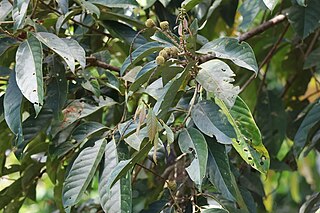Lithocarpus bennettii is a tree in the beech family Fagaceae. It is named for the English botanist John Joseph Bennett.
Lithocarpus bullatus is a tree in the beech family Fagaceae. The specific epithet bullatus means 'blistered', referring to the leaf surface.
Lithocarpus confragosus is a tree in the beech family Fagaceae. The specific epithet confragosus means 'uneven', referring to the cupule wall surface.
Lithocarpus coopertus is a tree in the family Fagaceae. The specific epithet coopertus means 'covered over', referring to the acorn.
Lithocarpus daphnoideus is a tree in the family Fagaceae. The specific epithet daphnoideus means "like Daphne", referring to the genus Daphne and its leaves.
Lithocarpus dasystachyus is a tree in the beech family Fagaceae. The specific epithet dasystachyus means 'thickly hairy spike', referring to the inflorescence.

Lithocarpus echinifer is a tree in the beech family Fagaceae. The specific epithet echinifer means 'having straight spines', referring to the cupule.
Lithocarpus echinulatus is a tree in the beech family Fagaceae. The specific epithet echinulatus means 'having short spines', referring to the cupule.

Lithocarpus elegans is a tree in the beech family Fagaceae. The specific epithet elegans means 'elegant', referring to the acorns and cupules.
Lithocarpus ewyckii is a tree in the beech family Fagaceae. It is named for D.J. van Ewijck van Oostbroek en De Built of the Dutch Colonial Service.
Lithocarpus ferrugineus is a tree in the beech family Fagaceae. The specific epithet ferrugineus means 'red-brown', referring to the acorn's indumentum.
Lithocarpus gracilis is a tree in the beech family Fagaceae. The specific epithet gracilis means 'slender', referring to the twigs.
Lithocarpus hatusimae is a tree in the beech family Fagaceae. It is named for the Japanese botanist Sumihiko Hatusima.
Lithocarpus hallieri is a tree in the beech family Fagaceae. It is named for the German botanist Johannes Gottfried Hallier.
Lithocarpus hystrix is a tree in the beech family Fagaceae. The specific epithet hystrix means 'spiny', referring to the cupule.
Lithocarpus jacobsii is a tree in the beech family Fagaceae. It is named for the Dutch botanist Marius Jacobs. Trees in Lithocarpus are commonly known as the stone oaks and differ from Quercus primarily because they produce insect-pollinated flowers.
Lithocarpus kalkmanii is a tree in the beech family Fagaceae. This species is named for the Dutch botanist Cornelis Kalkman.
Lithocarpus leptogyne is a tree in the beech family Fagaceae. The specific epithet leptogyne is from the Greek, referring to the slender female flower.

Lithocarpus lucidus is a tree in the beech family Fagaceae. The specific epithet lucidus means 'shining', referring to the acorn and leaf surface.
Lithocarpus meijeri is a tree in the beech family Fagaceae. It is named for the Dutch botanist Willem Meijer.


